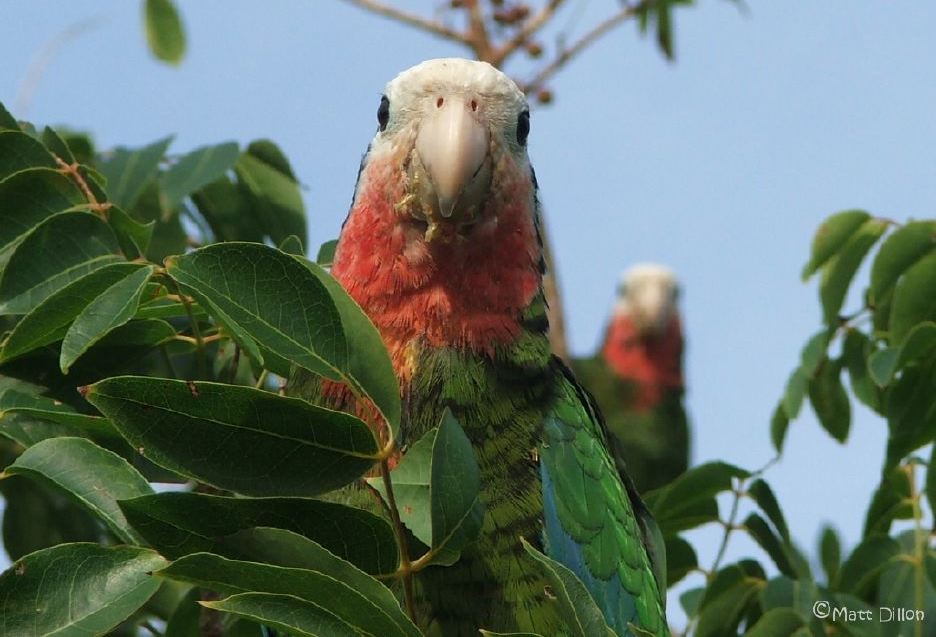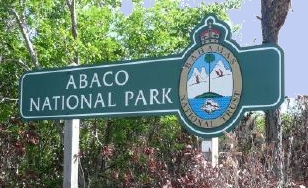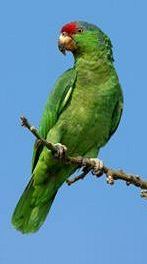From Sandy Estabrook Guide to the Abacos
The BAHAMIAN / ABACO PARROT

Photo Taken by Matt Dillon near his new home on Man-O-War Cay
The Bahama / Abaco parrot is a subspecies of the Cuban Amazon parrot. Locally (in Abaco) it is referred to at the Abaco Parrot because of the large numbers in the pine barrens of southeast Abaco. The Bahama Parrot's scientific name, Amazona lecocephala bahamensis, literally means, "white headed Amazon parrot from The Bahamas." Its white head and mostly green body make the Bahama parrot easily recognized. It has patches of red feathers on its cheek, throat and sometimes its abdomen; its flight feathers, usually hidden from sight when it is perched in a tree, are a beautiful cobalt blue. Viewers are often struck by this unexpected flash of color. The Bahama parrot's short, rounded bill is characteristic of all true parrots. The bill is a powerful multi-purpose tool used for eating, climbing, defending, preening (grooming) and playing. The Bahama parrot has two toes facing forwards and two facing backwards - a configuration known as zygodactylism. The Bahama parrot is 12-13 inches in length.
The Bahama Parrot eats a variety of fruits. They feed on wild guava, poisonwood berries, pigeon berry, and the fruit from gumbo-limbo and pond-top palm. Especially during the breeding season, Bahama parrots in Abaco eat the seed from the Pine trees. This provides a rich source of protein, essential for the development of Bahama parrot chicks.
The Inagua parrots use our national tree, Lignum vitae, the Mahogany and Black Mangrove trees for nesting. Abaco parrots look for limestone cavities on the ground of the pine forest to nest in. The female parrot lays two to four eggs. For 26 days she incubates them while her mate assumes responsibility for food. The eggs open 12 -72 hours apart. Parrot chicks hatch helpless, blind and almost completely featherless. By three weeks their eyes open. The chicks are fed regurgitated (predigested) food.
Historically, the Bahama Parrot occurred on several different Bahamian islands. Today, they are found only on Abaco and Great Inagua Islands. On Inagua the parrots live in the coppice areas and in Abaco they can be spotted here and about but their primary habitat is in the Abaco National Park which in Abaco's south east quarter along the unpaved road to Abaco's other Lighthouse at "Hole in the Wall".
There are less than 3,000 Bahama parrots remaining in The Bahamas. These birds are protected under the Wild Bird (Protection) Act. It is illegal to harm or capture or offer these birds for sale. A number of factors influence the survival of the Bahama parrot. The ground-nesting nature of the Bahama parrot in Abaco makes the population of these birds vulnerable to predation by feral (wild) cats, wild boars, crabs and snakes. Heavy rains during the nesting period can flood parrot nest holes, killing young chicks. Habitat loss is a constant threat to both populations of birds, hence habitat protection is very important to the survival of the Bahama parrot. The pet trade is another threat that is ever-present.
The BAHAMIAN / ABACO PARROT

Photo Taken by Matt Dillon near his new home on Man-O-War Cay
The Bahama / Abaco parrot is a subspecies of the Cuban Amazon parrot. Locally (in Abaco) it is referred to at the Abaco Parrot because of the large numbers in the pine barrens of southeast Abaco. The Bahama Parrot's scientific name, Amazona lecocephala bahamensis, literally means, "white headed Amazon parrot from The Bahamas." Its white head and mostly green body make the Bahama parrot easily recognized. It has patches of red feathers on its cheek, throat and sometimes its abdomen; its flight feathers, usually hidden from sight when it is perched in a tree, are a beautiful cobalt blue. Viewers are often struck by this unexpected flash of color. The Bahama parrot's short, rounded bill is characteristic of all true parrots. The bill is a powerful multi-purpose tool used for eating, climbing, defending, preening (grooming) and playing. The Bahama parrot has two toes facing forwards and two facing backwards - a configuration known as zygodactylism. The Bahama parrot is 12-13 inches in length.
The Bahama Parrot eats a variety of fruits. They feed on wild guava, poisonwood berries, pigeon berry, and the fruit from gumbo-limbo and pond-top palm. Especially during the breeding season, Bahama parrots in Abaco eat the seed from the Pine trees. This provides a rich source of protein, essential for the development of Bahama parrot chicks.
The Inagua parrots use our national tree, Lignum vitae, the Mahogany and Black Mangrove trees for nesting. Abaco parrots look for limestone cavities on the ground of the pine forest to nest in. The female parrot lays two to four eggs. For 26 days she incubates them while her mate assumes responsibility for food. The eggs open 12 -72 hours apart. Parrot chicks hatch helpless, blind and almost completely featherless. By three weeks their eyes open. The chicks are fed regurgitated (predigested) food.
Historically, the Bahama Parrot occurred on several different Bahamian islands. Today, they are found only on Abaco and Great Inagua Islands. On Inagua the parrots live in the coppice areas and in Abaco they can be spotted here and about but their primary habitat is in the Abaco National Park which in Abaco's south east quarter along the unpaved road to Abaco's other Lighthouse at "Hole in the Wall".

There are less than 3,000 Bahama parrots remaining in The Bahamas. These birds are protected under the Wild Bird (Protection) Act. It is illegal to harm or capture or offer these birds for sale. A number of factors influence the survival of the Bahama parrot. The ground-nesting nature of the Bahama parrot in Abaco makes the population of these birds vulnerable to predation by feral (wild) cats, wild boars, crabs and snakes. Heavy rains during the nesting period can flood parrot nest holes, killing young chicks. Habitat loss is a constant threat to both populations of birds, hence habitat protection is very important to the survival of the Bahama parrot. The pet trade is another threat that is ever-present.
|
|
Don't confuse the Bahamian Parrot with the smaller Florida / Red-crowned Parrot - Amazona viridigenalis. shown here. Their appearance is generally green with the most notable features being dark blue streaks behind the eyes, a bright red forehead and crown with light green cheeks. Their natural range is across the lowlands of Northeastern Mexico to urban communities of southern California, Texas and southern Florida. |

